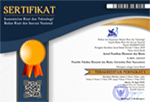Analisis Pengaruh Intensitas Modal, Intensitas Persediaan, Komisaris Independen dan Kepemilikan Manajerial Terhadap ETR
DOI:
https://doi.org/10.33633/jpeb.v5i1.2707Abstract
This study aims to analyze the effect of capital intensity, inventory intensity, independent board of commissioners and managerial ownership on the effective tax rate. The population in this study are manufacturing companies listed on the Indonesia Stock Exchange (IDX) in 2015-2017. The sample selection uses the purposive sampling method. The results of the sample selection obtained a final sample of 75 companies with an analysis unit of 225. The data analysis of this study used descriptive statistical analysis and Structural Analysis Modeling (SEM) with AMOS 22 software. The results showed that inventory intensity had a significant positive effect on ETR, while for intensity capital, independent board of commissioners and managerial ownership, have no significant effect on ETR. The conclusion of this study is that the size of ETR in manufacturing companies is influenced by inventory intensity. Whereas capital intensity, independent board of commissioners and managerial ownership in manufacturing companies cannot influence the size of the ETR value.Keywords: ETR; Capital Intensity; Managerial ownershiPenelitian ini bertujuan untuk menganalisis pengaruh intensitas modal, intensitas persediaan, dewan komisaris independen dan kepemilikan manajerial terhadap effective tax rate. Populasi dalam penelitian ini adalah perusahaan manufaktur yang terdaftar di Bursa Efek Indonesia (BEI) pada tahun 2015-2017. Pemilihan sampel menggunakan metode puposive sampling. Hasil seleksi sampel diperoleh sampel akhir sebanyak 75 perusahaan dengan unit analisis sebanyak 225. Analisis data penelitian ini menggunakan analisis statistik deskriptif dan Structural Analysis Modelling (SEM) dengan software AMOS 22. Hasil penelitian menunjukkan bahwa intensitas persediaan berpengaruh positif signifikan terhadap ETR, sedangkan untuk intensitas modal, dewan komisaris independen dan kepemilikan manajerial, tidak berpengaruh signifikan terhadap ETR. Simpulan dari penelitian ini adalah besar kecilnya ETR dalam perusahaan manufaktur dipengaruhi oleh intensitas persediaan. Sedangkan intensitas modal, dewan komisaris independen dan kepemilikan manajerial dalam perusahaan manufaktur tidak dapat mempengaruhi besar kecilnya nilai ETR. Kata Kunci: ETR; Intensitas Modal; Kepemilikan ManajerialReferences
Amelia, V. (2014). Pengaruh Ukuran Perusahaan, Leverage, Profitabilitas, Intensitas Aset Tetap, Intensitas Persediaan dan Komisaris Independen Terhadap Effective Tax Rate, 203.
Ardyansah, dan Zulaikha. (2014). Pengaruh Size, Leverage, Profitability, Capital Intensity Ratio Dan Komisaris Independen Terhadap Effective Tax Rate (Etr). Diponegoro Journal of Accounting, 3(2), 1–9.
Ayuningtyas, R. (2018). Determinat Effective Tax Rate dari Sudut Pandang Corporate Governance dan Kepemilikan Saham Publik.
Bakri, N. (2008). Analisis Hubungan dan Pengaruh Independensi dan Pengalaman Dewan Komisaris Terhadap Cost Of Deb. Thesis Dipublikasikan, Fakultas Ekonomi, Universitas Indonesia.
Boediono, G. (2005). Kualitas Laba: Studi Pengaruh Mekanisme Corporate Governance dan Dampak Manajemen Laba dengan Menggunakan Analisis Jalur. Simposium Nasional Akuntansi (SNA) VIII Solo.
Boussaidi, A. (2015). The Impact of Goverance Mechanism on Tax Aggressiveness: Empirical Evidence From Tunissian Context. Journal of Asian Business Strategy, Vol.5(1).
Chiao, & Immordino-Yang. (2013). Modularity and the Cultural Mind: Contributions of Cultural Neuroscience to Cognitive Theory. Perspectives on Psychological Science, 8(1), 56–61.
Chiou, Hsieh, & Lin. (2015). Determinants of effective tax rates for firms listed on Chinese stock market: Panel models with two-sided censors. Journal of Economic & Financial Studies, 3(1), 306–312.
Damayanti, F. dan T. S. (2015). Pengaruh Komite Audit, Kualitas Audit, Kepemilikan Institusional, Risiko Perusahaan Dan Return On Assets Terhadap Tax Avoidance. Jurnal Bisnis Dan Manajemen UIN Syarif Hidayatullah Jakarta, Vol 5.
Hadi dan Yenni. M. (2014). Pengaruh Struktur Kepemilikan dan Karakteristik Dewan Terhadap Agresivitas Pajak. Tax And Accounting Review, Vol. 4, No, 1–10.
Hanum, (2013). Pengaruh Karakteristik Corporate Governance Terhadap Effective Tax Rate. Diponegoro Journal of Accounting, 1–54.
Ikhsan dan Ishak (2005). Akuntansi Keprilakuan. Jakarta: Salemba Empat.
Karayan, J. E. and C. W. Swenson. (2007). Strategic Business Tax Planning (2nd editio). New Jersey: John Wiley & Sons Inc.
Kartika Pertiwi. (2016). Pengaruh Intensitas Modal. Leverage, Intensitas Persediaan, Transaksi Perusahaam, dan transfer Pricing Terhadap Tarif Pajak Efektif, 1–15.
Liu (2007). Determinants of Corporate Effective Tax Rates. The Chinese Economy,
PSAK No.14. Tentang Persediaan.
Rodriguez, dan Arias. (2013). Do Business Characteristics Determine an Effective Tax Rate? The Chinese Economy.
Sabli, Noor (2012). Tax Planning and Coporate Governancet.
Vidiyanna dan Rizal Putri. (2018). Analisis Faktor Yang Mempengaruhi Effective Tax Rate. Jurnal Politeknik Caltex Riau, 11(1), 42–51.
Wulandari, M. dan Dovi. S. (2015). Effective Tax Rate: Efek dari Corporate Governance. Jurnal Politeknik Negeri
Batam, 1–6.
www.idx.co.id. Diakses pada 1 Maret 2019.
Yeye, S., Widyawat Ratih, & Nuraini. (2018). Intensity Ratio dan Komisaris Independen Terhadap Effective Tax Rate, 796–804.
Zain, M. (2008). Manajemen Perpajakan. Salemba Empat. Jakarta.
Downloads
Published
How to Cite
Issue
Section
License
The copyright of the received article shall be assigned to the journal as the publisher of the journal. The intended copyright includes the right to publish the article in various forms (including reprints). The journal maintains the publishing rights to the published articles.
This work is licensed under a Creative Commons Attribution 4.0 International License.


.png)









